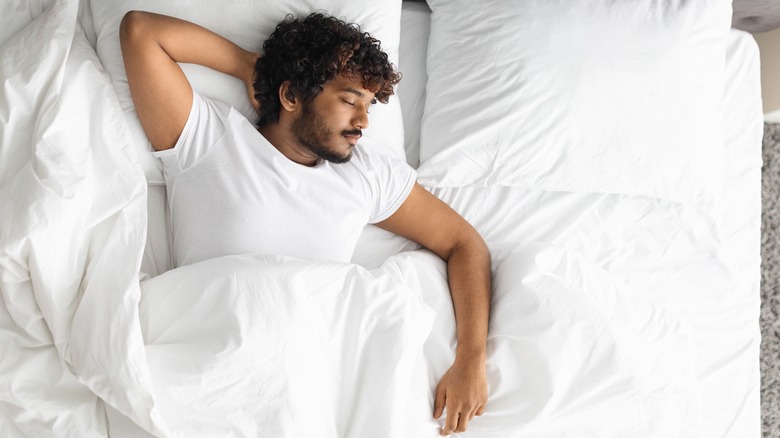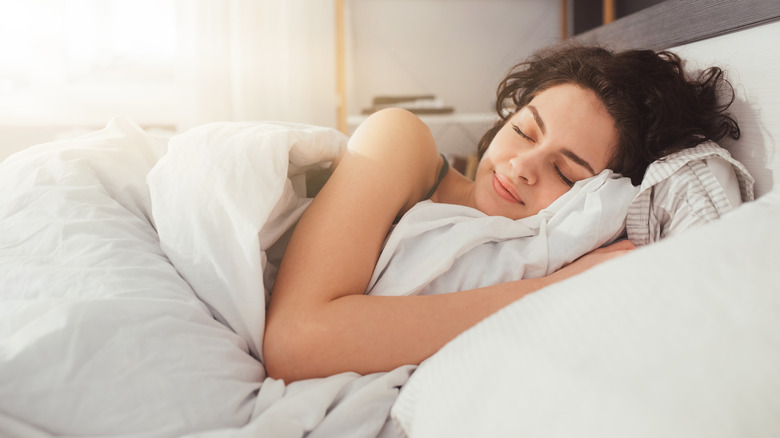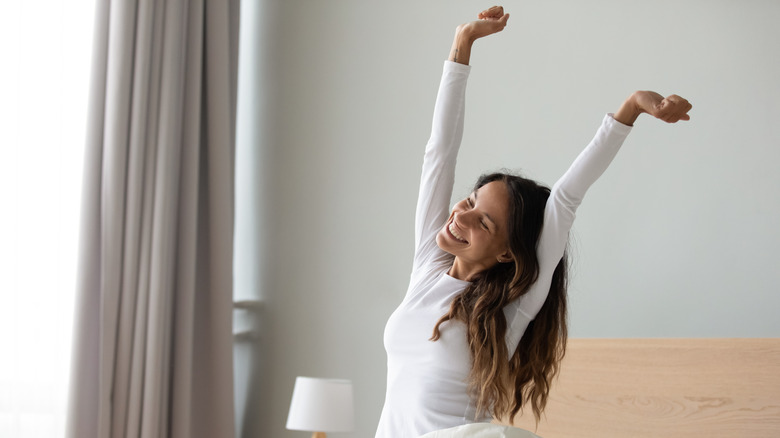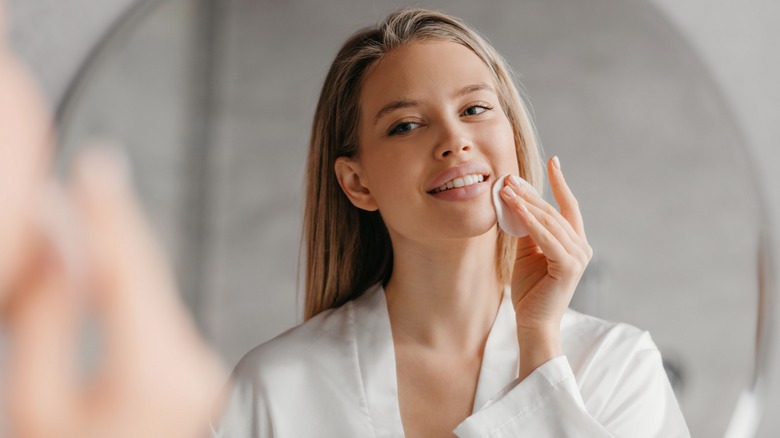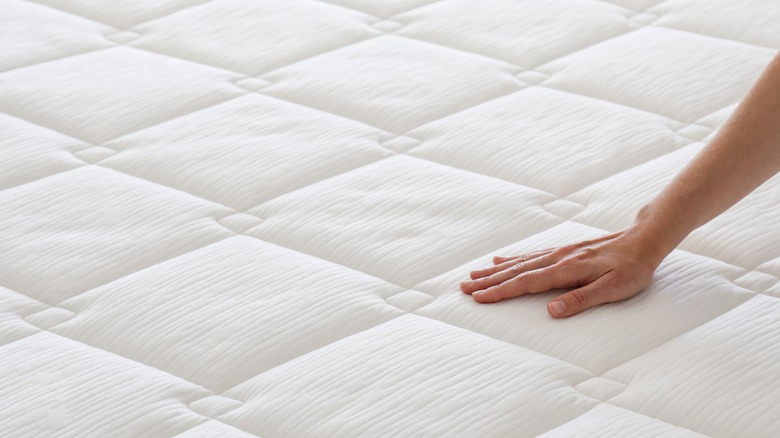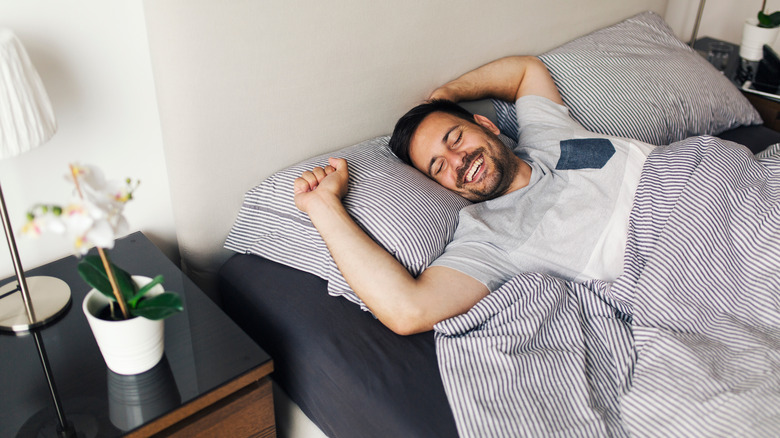The Benefits Of Sleeping On Your Back And How To Train Yourself To Actually Do It
We may receive a commission on purchases made from links.
Each person has their own preferred sleeping position, and if you're comfortable and regularly sleep through the night in yours, there's no need to change, per the Sleep Foundation. However, perhaps you struggle to stay asleep or often feel sore in the morning, in which case, maybe you should test out a different position.
According to Nine, only 10% of people sleep on their backs. Sometimes called supine sleeping or the starfish position (when your limbs are extended outwards, via MedicalNewsToday), sleeping on your back with your spine straight may cause you to get more rest and feel less back or neck pain. Further, it could also aid those struggling with congestion or concerned about beauty changes like wrinkles and breakouts. However, this choice isn't the best for everyone.
Below, you'll discover if back sleeping could be a good choice for you, the many health and skin-related benefits, how to optimize your bed for rest, and how to train yourself to sleep in this position.
The best sleeping position?
While there are plenty of different positions to sleep in, they all boil down to three main categories: sleeping on your stomach, side, or back. According to WebMD, sleeping on your stomach is the worst position, as it can easily cause neck or back pain. This is because your neck is forced to turn to the side when sleeping in this manner. If you can only fall asleep this way, experts recommend placing your forehead on a soft pillow and keeping your face down towards the mattress.
Most agree that side and back sleeping are the best options — however, your specific situation will determine which one is best for you. If you often wake up with jaw or shoulder pain or if you're worried about wrinkles, sleeping on your side is not optimal, per the Sleep Foundation. The fetal position can also make it more difficult to breathe.
For most people, the best sleeping position is on your back, as it comes with a number of benefits, which you'll discover below. However, if you're pregnant, often snore, have sleep apnea, or are an older or heavier adult, sleeping on your side may be best.
Health benefits
Beginning with the health benefits, the most notable pro to sleeping on your back is that it often relieves back pain, per Healthline. Further, if you experience less back pain, you may also find relief from tension headaches, pressure in the head or body, or shoulder aches. However, keep in mind that some say that it actually worsens back or hip pain, so you'll need to test it out for yourself. There are also ways to combat this pain, such as placing a pillow beneath your knees and lower back or stretching before bed.
Sleeping on your back can also relieve cold symptoms such as congestion as it promotes the drainage of the sinuses, per Nine. And Ear, Nose & Throat Associates says that it can also help you breathe better, no matter what your health status is. Further, it puts less pressure on your internal organs. Those who struggle with heart conditions, heartburn, or acid reflux could also sleep on their back as long as their head is slightly elevated, but sleeping on their side is also a great choice.
Skin-related benefits
However, the pros don't stop there, as sleeping on your back also comes with skin-related benefits. Basically, all these benefits are because your face isn't pressed up against a pillow when sleeping on your back. According to Dermstore, this means that you'll develop fewer face and neck wrinkles. Those who often sleep on the same side each night may notice more wrinkles on one side of their face and not the other, but this isn't a concern for back sleepers.
Those who use skincare products or moisturizers before going to bed will also benefit, as these products won't transfer onto your pillow and, therefore, can thoroughly absorb into your skin. Ear, Nose & Throat Associates says that, since your face isn't pressed up against your pillow, it won't be exposed to as much oil or bacteria, meaning you could experience not only fewer breakouts but also less skin irritation. Finally, you may also notice less temporary puffiness around your eyes in the morning, which you could see if you slept on your side or stomach.
Optimizing your bed
In order to sleep on your back, you'll need to create the right environment, which basically means choosing the right mattress and pillow and positioning smaller pillows in the right places. Healthline says that a firmer mattress is better than a softer one, as your muscles may stiffen in an attempt to keep yourself from sinking into a soft bed.
When it comes to choosing the right pillow to support your head and neck, don't decide upon one that's too large or fluffy. Instead, Layla recommends one with medium fullness, which will allow your body and head to stay aligned throughout the night. However, those who snore or have sleep apnea should slightly elevate their head above the rest of their body. You could also place a smaller pillow or a rolled-up towel underneath your neck. Finally, if you regularly have back pain, pillows should also be placed underneath your knees and lower back, per MedicalNewsToday.
Tips on training yourself
Before you attempt to train yourself to sleep on your back every night, it's important to recognize that developing a habit can take quite a while, so practice patience and stick to a regular sleeping routine.
The Thirty says that there are two main reasons why you may not naturally sleep on your back: either you like your face up against a pillow or lying on your back causes back pain. If you like a pillow up against your face, place a small one against your ear and side. If you struggle with back pain, always stretch before bed and place pillows underneath your knees and lower back.
Another way to try to develop this habit is by elevating your head and torso, as this could make it more difficult for you to turn over in the night. Further, Healthline recommends surrounding yourself with pillows and using a weighted eye mask. Nine also says to associate lying on your back with pleasant things by listening to music you enjoy or soothing sounds while in this sleeping position.
